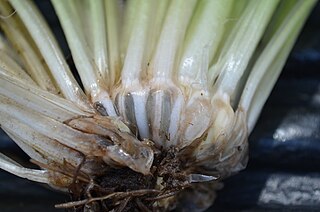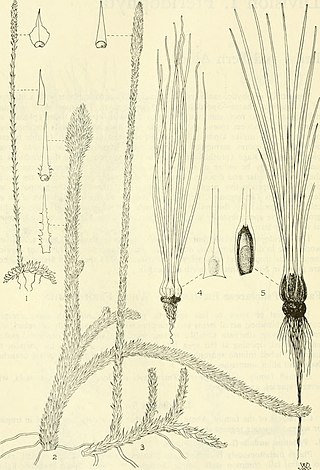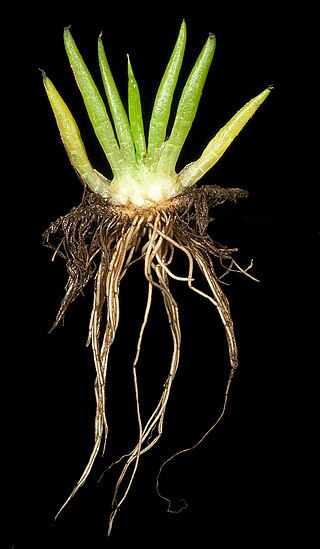
Isoetes, commonly known as the quillworts, is a genus of lycopod. It is the only living genus in the family Isoetaceae and order Isoetales. There are currently 192 recognized species, with a cosmopolitan distribution mostly in aquatic habitats but with the individual species often scarce to rare. Some botanists split the genus, separating two South American species into the genus Stylites, although molecular data place these species among other species of Isoetes, so that Stylites does not warrant taxonomic recognition. Species virtually identical to modern quillworts have existed since the Jurassic epoch, though the timing of the origin of modern Isoetes is subject to considerable uncertainty.

Equisetum fluviatile, the water horsetail or swamp horsetail, is a vascular plant that commonly grows in dense colonies along freshwater shorelines or in shallow water in ponds, swamps, ditches, and other sluggish or still waters with mud bottoms. It is a perennial herbaceous species, growing 30–100 cm tall with erect dark green stems 2–8 mm in diameter, smooth, with about 10–30 fine ridges. At each joint, the stem has a whorl of tiny, black-tipped scale leaves 5–10 mm long. Many, but not all, stems also have whorls of short ascending and spreading branches 1–5 cm long, with the longest branches on the lower middle of the stem. The side branches are slender, dark green, and have 1–8 nodes with a whorl of five scale leaves at each node. The water horsetail has the largest central hollow of the horsetails, with 80% of the stem diameter typically being hollow.

Isoetes lacustris, the lake quillwort or Merlin's grass, is a boreal quillwort native on both sides of the northern Atlantic Ocean. Synonyms include Isoetes hieroglyphica.

Arabia Mountain, a part of Arabia Mountain National Heritage Area, is the northern of two peaks in the Davidson-Arabia Mountain Nature Preserve, in DeKalb County, Georgia, United States. A low saddle separates it from Bradley Mountain, several hundred feet to its south. The two form a monadnock. The peak is 955 feet (290 m) above sea level, rising 172 feet (52 m) above Arabia Lake reservoir. Bradley Mountain is closer to the visitor trails than Arabia Mountain and is often misidentified by visitors as Arabia Mountain.
Pleuromeia is an extinct genus of lycophytes related to modern quillworts (Isoetes). Pleuromeia dominated vegetation during the Early Triassic all over Eurasia and elsewhere, in the aftermath of the Permian–Triassic extinction event. During this period it often occurred in monospecific assemblages. Its sedimentary context in monospecific assemblages on immature paleosols, is evidence that it was an opportunistic pioneer plant that grew on mineral soils with little competition. It spread to high latitudes with greenhouse climatic conditions.

Isoetes engelmannii is a species of aquatic plant in the family Isoetaceae. It is referred to by the common names Engelmann's quillwort or Appalachian quillwort, and is the most widely distributed species of its genus in eastern North America. Its range extends from Ontario in the north, south to Florida and west Arkansas and Missouri. It can be found from April to October in temporary pools, bogs, marshes, stream edges, swamps and along wet roadsides.
Isoetes valida, commonly known as the strong quillwort or true quillwort, is an aquatic lycophyte native to eastern North America. It is found primarily in the Appalachian Mountains from Pennsylvania south to Alabama and Georgia. In addition, one collection of the plant was made in a railway ditch in Wilmington, Delaware in the 1860s, but this was most likely an accidental introduction.

Isoetes melanospora, commonly known as black-spored quillwort or black-spored Merlin's grass, is a rare and endangered aquatic lycophyte endemic to the U.S. states of Georgia and South Carolina.
Isoetes nuttallii, or Nuttall's quillwort, is a species of quillwort, a type of lycopod. It is native to shallow waters and other wet habitats of western North America from British Columbia to California. It produces up to 60 pointed, cylindrical, green to gray-green leaves, each 7 to 17 centimeters long. The velum completely covers the spherical sporangia, which are 5 millimeters long and 1.5 millimeters wide. The ligule is small and triangular. The megaspores are 400 to 500 micrometers in diameter. The microspores, which are spiny and covered in tubercles, are 28 to 31 micrometers long.
Isoetes caroliniana, common name Carolina quillwort, is a wetlands plant native to the mountains of Tennessee, North Carolina, Virginia and West Virginia. It is an emergent plant found in lakes and bogs. It is closely related to I. georgiana but can be distinguished by its unpigmented sporangium wall.

Isoetes riparia, the shore quillwort, is a species of plant in the family Isoetaceae. It can be found in rivers, creeks, and tidal mud flats in southern Quebec and southeastern Ontario, south to eastern New York. It has 5 to 35 long, erect bright green to yellow-green leaves, which are 6 to 35 centimeters long. The velum covers one fourth of the sporangium, which can be 7 millimeters long and 4 millimeters wide. The elongated ligule can grow to be 3 millimeters long. The spherical megaspores are 430 to 680 micrometers in diameter with closely set ridges. The kidney-shaped microspores are 24-35 micrometers long, and usually have spine-tipped tubercules. The megaspores can sometimes come to resemble that of either I. echinospora, if the megaspores become eroded and bear projections that could resemble spines, or I. macrospora, if the broken ridges take a certain shape.

Isoetes mississippiensis, the Mississippi quillwort, is a small aquatic pteridophyte from the family Isoetaceae.

Protea namaquana, also known as the Kamiesberg sugarbush, is a flowering plant which belongs to the genus Protea. The plant is endemic to the southwestern Cape Region of South Africa, in particular the Kamiesberg mountains of Namaqualand in the Northern Cape province. The species has a worldwide distribution of only 18 km2. It is regarded as critically endangered. In the Afrikaans language it has the vernacular name is Kamiesbergsuikerbos.

Isoetes muelleri is a species of quillwort, a type of lycophyte. This generally apomictic aquatic plant is native to Australia.

Colpias is a monotypic genus of flowering plant in the family Scrophulariaceae. It has only one currently accepted species, Colpias mollis, native to South Africa. It secretes oils to attract specialised oil-collecting bees from the genus Rediviva. It is also known by the name klipblom, meaning stone plant in Afrikaans.

Isoetes melanopoda is a species of nonflowering vascular plant belonging to the quillworts in the family Isoetaceae. Its common names include: black-footed quillwort, midland quillwort, and prairie quillwort.

Isoetes australis is quillwort and was first described in 1943 by Samuel Williams.
Isoetes capensis, the cape quillwort, is a species of quillwort from South Africa.
Isoetes stellenbossiensis, the Stellenbosch quillwort or Cape Flats quillwort, is a species of plant from South Africa.
Isoetes stephanseniae, the granite quillwort, is a species of quillwort from South Africa, named for A. J. Stephansen, who discovered it in 1927. Of very limited distribution, it is known to survive only as one population in seasonal pools over granite near Stellenbosch, where it is threatened by the encroachment of alien species and eutrophication from the sewage works on whose grounds it grows. Like other quillworts, it bears a tuft of leaves with distinctively sculpted megaspores. It is most similar to Isoetes capensis, the cape quillwort, which occurs in the same province; both hold their leaves at a 45-degree angle, unlike most South African quillworts which have leaves stiffly erect.












